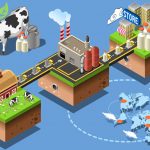8th Global Agenda for Sustainable Livestock Meeting features preview of Dairy’s Role in Poverty Reduction Study
The global livestock sector set out priorities that will help optimize livestock’s social, economic and health benefits while balancing its environmental impact at 8th Global Agenda for Sustainable Livestock (GASL) meeting in Mongolia. With the Sustainable Development Goals of the UN Agenda 2030 serving as the reference frame, the discussions in Mongolia mapped how GASL can continue to deliver through its Clusters and Action Networks in view of recent emerging opportunities for the livestock sector.
Presented at the meeting was an advanced preview of a new report, co-authored by the United Nation’s Food and Agriculture Organization (FAO) and the IFCN Dairy Research Network and support by the Global Dairy Platform, that documents the poverty reduction benefits of the global dairy sector.
The extensive review of research found that in all household-level studies, owning a dairy cow or improving dairy production had a substantial positive impact on poverty reduction. This included increasing household income by up to 600 per cent, increasing milk consumption and nutrition by up to 900 per cent, and generating more employment opportunities.
“Dairy has the power to provide a major pathway out of poverty for individuals, families, and whole communities, providing them the means to access the necessities of life – food, water, shelter and clothing – more easily,” said Donald Moore, Executive Director of the Global Dairy Platform.
The study paper is currently under final review and is expected to by publish for public distribution by the fall of 2018.
The five-day flagship event, which convenes organizations from across the livestock sector, set out four key areas where livestock’s potential could be more effectively leveraged to support global development.
- Food and nutrition security: for example, by raising awareness that micronutrient deficiencies affecting more than two billion people globally can be addressed with animal-source foods;
- Livelihoods and economic growth: acknowledging an estimated one billion people worldwide rely on livestock for livelihoods and income, for instance;
- Health and animal welfare: for example, by demonstrating to policymakers that every dollar invested in tackling diseases of animal origin generates an estimated five dollars’ worth of benefits;
- Climate and natural resources: livestock can make use of two thirds of the world’s arable land, which is unsuitable for cropping, while reducing livestock’s carbon “hoofprint”, for instance.
“Poverty and hunger eradication are among the greatest global challenges facing the world today and an indispensable requirement for sustainable development,” said Fritz Schneider, Chair of GASL. “The livestock sector must move in the right direction to achieve this balance of becoming ever more productive and sustainable at the same time.”





